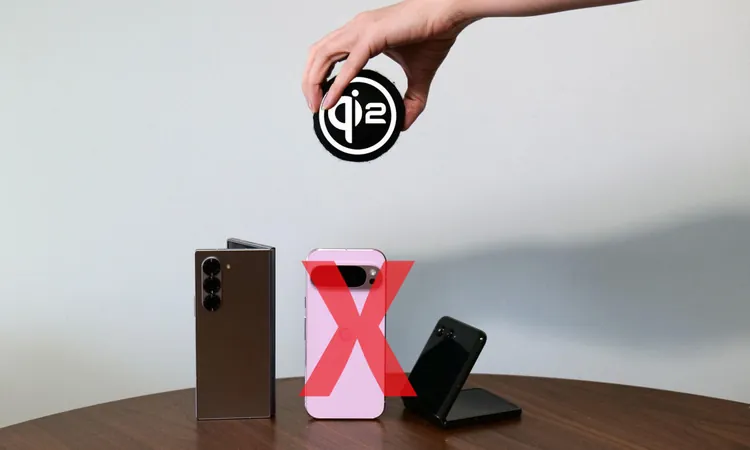
Android Phone Manufacturers Miss the Mark with Qi2 in 2024!
2024-12-24
Author: Jessica Wong
Introduction
In a world where Android devices have consistently led the charge in adopting groundbreaking technologies, the sluggish response to the Qi2 wireless charging standard in 2024 has left many users scratching their heads. Known for being the pioneers of various innovative features—including 4G, 5G, USB-C, and in-screen fingerprint sensors—it seems ironic that Android manufacturers are now lagging behind when it comes to wireless charging advancements.
The Qi2 Wireless Charging Standard
The Qi2 standard was unveiled at CES 2023, garnering substantial attention for its promise of 15-watt wireless charging and improved user safety, alongside the introduction of Magnetic Power Profiles. This new technology aims to simplify the wireless charging experience for Android users, mimicking the convenience already enjoyed by iPhone owners with Apple's MagSafe accessories.
Apple's Collaboration and Missed Signals
A particularly fascinating detail? Apple, typically secretive with its tech innovations, chose to share integral components of the MagSafe specification with other members of the Wireless Power Consortium to foster development and compatibility across platforms. This collaboration should have sent a clear signal to Android manufacturers about the potential of Qi2, especially given the popularity of MagSafe among iPhone users. Yet, astonishingly, nearly two years post-announcement, only one Android device—the HMD Skyline—has embraced Qi2 support.
Critique of Development Cycles
Critics may point to the complexities of product development cycles as a reason for this oversight. While it’s true that creating new tech often requires years of planning, industry giants like Samsung, Google, and Lenovo would have had ample warning about Qi2's impending arrival. After all, with the first iPhone equipped with MagSafe launching in 2020, these manufacturers had more than enough time to integrate a similar feature into their latest smartphone offerings.
Concerns About Accessory Availability
Some manufacturers' hesitations may stem from concerns about a lack of supporting accessories, reminiscent of past failures with modular devices like the LG G5. However, due to the interoperability between Qi2 and MagSafe products, an expansive market of compatible gadgets already exists. Brands like Anker have rolled out numerous Qi2-compatible power banks, showcasing that accessory availability shouldn't be a barrier.
Magnetic Attachment Issues
Interestingly, certain models, including the Razr Plus and Pixel 9 Pro Fold, can attach magnetically to some Qi2 accessories, albeit unintentionally. This phenomenon, resulting from design elements related to the devices' foldable nature, is more likely to frustrate than satisfy users, as these accessories often fail to maintain a secure connection.
Manufacturers' Reluctance
Furthermore, the reluctance of some Chinese manufacturers, such as Oppo, to adopt Qi2 technology is somewhat understandable; they often prioritize proprietary systems like AirVOOC. The recent release of the Galaxy S24 series at the beginning of 2024 may also explain Samsung's delayed adoption of Qi2 in their flagship lineup, compared to Google’s Pixel 9 series.
Conclusion
What’s undeniably frustrating is the missed opportunity for Android manufacturers to unlock Qi2 support across a broader range of devices with relatively minor adjustments. In an age where seamless user experience should be a top priority, the lack of progress on this front feels like a significant oversight.
Final Thoughts
As consumers increasingly turn their attention to convenient, user-friendly technologies, it raises an essential question: Will Android manufacturers step up their game and embrace Qi2, or will they continue to falter in the face of innovation? The answer could determine how they stay competitive in a rapidly evolving tech landscape.


 Brasil (PT)
Brasil (PT)
 Canada (EN)
Canada (EN)
 Chile (ES)
Chile (ES)
 España (ES)
España (ES)
 France (FR)
France (FR)
 Hong Kong (EN)
Hong Kong (EN)
 Italia (IT)
Italia (IT)
 日本 (JA)
日本 (JA)
 Magyarország (HU)
Magyarország (HU)
 Norge (NO)
Norge (NO)
 Polska (PL)
Polska (PL)
 Schweiz (DE)
Schweiz (DE)
 Singapore (EN)
Singapore (EN)
 Sverige (SV)
Sverige (SV)
 Suomi (FI)
Suomi (FI)
 Türkiye (TR)
Türkiye (TR)